Our Summary
The research paper talks about a case of a 28-year-old woman who had a rare condition known as massive ovarian edema, where her ovary was filled with excess fluid, making it look like a solid ovarian tumor. This condition could be easily misdiagnosed as a tumor, which could lead to unnecessary removal of the ovary.
In this case, the woman had been experiencing lower abdominal pain for a week and was found to have two ovarian masses through an ultrasound examination at a local clinic. She was then referred to a hospital for further examination. A more detailed scan and MRI revealed a cystic and a solid lesion in her left ovarian region. There were no abnormalities in her right ovarian region or uterus.
The doctors suspected massive ovarian edema with a twisted cyst near the ovary and decided to perform a laparoscopic surgery, a minimally invasive surgery using a small incision and a camera. During the surgery, they found a twisted cyst near the ovary, and after untwisting it, the size of the swollen ovary reduced to almost normal.
Instead of removing the whole ovary, they only removed the twisted cyst, preserving the ovary. The removed cyst was examined and confirmed to be a benign tumor called serous cystadenoma.
The study suggests that doctors should consider the possibility of massive ovarian edema when they encounter a complex solid ovarian mass, especially in patients with a history of recurrent abdominal pain. This can avoid unnecessary removal of the ovaries.
FAQs
- How can massive ovarian edema be misdiagnosed as a tumor?
- What is the process for diagnosing and treating massive ovarian edema?
- Why is it important for doctors to consider the possibility of massive ovarian edema when encountering a solid ovarian mass?
Doctor’s Tip
A helpful tip a doctor might tell a patient about ovarian cyst removal is to make sure to discuss all possible options with your healthcare provider before proceeding with surgery. In some cases, like the one mentioned in the research paper, it may be possible to preserve the ovary by removing only the cyst. It’s important to advocate for yourself and ask questions to ensure you are making the best decision for your health.
Suitable For
Patients who may be recommended for ovarian cyst removal include those with:
- Large cysts (over 5 centimeters) that are causing symptoms such as pelvic pain, bloating, or pressure
- Cysts that are persistent or growing in size
- Complex cysts that have solid components or irregularities on imaging studies
- Cysts that are causing infertility or affecting fertility treatments
- Cysts that are suspected to be malignant or have a high risk of becoming cancerous
- Cysts that are causing complications such as torsion (twisting), rupture, or hemorrhage
It is important for doctors to carefully evaluate each individual case and consider factors such as the patient’s age, symptoms, risk factors, and overall health before recommending ovarian cyst removal. In cases where there is uncertainty about the nature of the cyst or the best course of treatment, a second opinion from a specialist may be beneficial.
Timeline
After the surgery, the patient experienced some mild pain and discomfort at the incision site, which was managed with pain medication. She was discharged from the hospital a few days after the surgery and was advised to take it easy and avoid heavy lifting or strenuous activities for a few weeks.
Follow-up appointments were scheduled to monitor her recovery and ensure that there were no complications or recurrence of the cyst. The patient was also advised to monitor her symptoms and report any unusual or concerning changes to her healthcare provider.
Overall, the patient had a successful surgery with minimal complications and was able to preserve her ovary, which is important for maintaining hormonal balance and fertility. The removal of the cyst alleviated her symptoms and improved her quality of life.
What to Ask Your Doctor
- What is the reason for recommending ovarian cyst removal in my case?
- Are there any alternative treatment options available besides surgery?
- What are the potential risks and complications associated with the surgery?
- What is the recovery time expected after the surgery?
- Will removing the cyst affect my fertility or hormone levels?
- How will the surgery be performed (laparoscopic vs. open surgery)?
- What is the likelihood of the cyst being cancerous?
- Will I need any follow-up appointments or monitoring after the surgery?
- What are the chances of the cyst recurring in the future?
- Are there any lifestyle changes or precautions I should take post-surgery to prevent future cysts?
Reference
Authors: Fukuda T, Imai K, Yamauchi M, Kasai M, Ichimura T, Yasui T, Sumi T. Journal: Med Int (Lond). 2021 Oct 12;1(5):17. doi: 10.3892/mi.2021.17. eCollection 2021 Nov-Dec. PMID: 36698534
